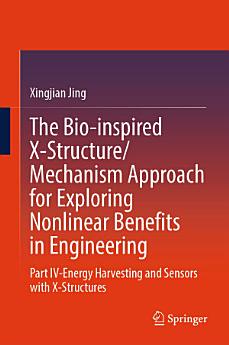The Bio-inspired X-Structure/Mechanism Approach for Exploring Nonlinear Benefits in Engineering: Part IV-Energy Harvesting and Sensors with X-Structures
About this ebook
About the author
Prof. Xingjian Jing received his B.S. degree from Zhejiang University, China, M.S. degree and Ph.D. degree in Robotics from Shenyang Institute of Automation, Chinese Academy of Sciences, China, respectively. He also achieved a Ph.D. degree in nonlinear systems and signal processing from University of Sheffield, U.K.. He is now a Professor with the Department of Mechanical Engineering, City University of Hong Kong, and his current research interests are generally related to Nonlinear Dynamics, Vibration, Control and Robots, focusing on theory and methods for employing nonlinear benefits in engineering, including nonlinear frequency domain methods, nonlinear system identification or signal processing, vibration control, robust control, sensor technology, energy harvesting, nonlinear fault diagnosis or information processing, bio-inspired systems and methods, bio-inspired robotics and control etc. He is the recipient of a series of academic and professional awards including 2016 IEEE SMC Andrew P. Sage Best Transactions Paper Award, 2017 TechConnect World Innovation Award in US, 2017 EASD Senior Research Prize in Europe and 2017 the First Prize of HK Construction Industry Council Innovation Award. He has published more than 250 refereed journal papers and obtained 30+ patents filed in China and US. He currently serves or has served as Associate Editors for IEEE Transactions on Systems Man Cybernetics-Systems, IEEE Transactions on Industrial Electronics, and IEEE/ASME Transactions on Mechatronics, Senior Editor for Mechanical Systems and Signal Processing, Topic Associate Editor for Nonlinear Dynamics, Specialty Chief Editor on Vibration Systems of Frontiers in Mechanical Engineering and the founding EiC for Applied Nonlinear Dynamics and Vibrations. He was Lead Editor of special issues on ‘Exploring nonlinear benefits in engineering’ published in Mechanical Systems and Signal Processing in 2018/2019 and 2021/2022, and has been the General Chair of the International Conference on Applied Nonlinear Dynamics, Vibration, and Control since 2021.





